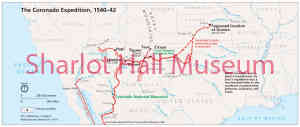Previously: While the Coronado Expedition was at Zuni in the summer of 1540, Pedro de Tovar made the first European contact with the Hopi. Garcia Lopez de Cardenas became the first European to see the Grand Canyon. The Hopi were no happier to see the Spaniards than the Zuni had been.
 By October the expedition moved east toward native pueblos along the Rio Grande -- a province the Spaniards called Tiguex (tee-wish). Coronado’s men again asserted their dominion over the natives, and Cardenas became notorious for brutal, murderous retaliation against any resistance. Anger and frustration were rising among the Spaniards who had expected by this time to be dripping in gold and jewels. Fray Marcos, whose fantasies sparked the expedition, was sent back to Mexico in disgrace. The next man who promised to lead Coronado to cities of gold would be dealt with more harshly.
By October the expedition moved east toward native pueblos along the Rio Grande -- a province the Spaniards called Tiguex (tee-wish). Coronado’s men again asserted their dominion over the natives, and Cardenas became notorious for brutal, murderous retaliation against any resistance. Anger and frustration were rising among the Spaniards who had expected by this time to be dripping in gold and jewels. Fray Marcos, whose fantasies sparked the expedition, was sent back to Mexico in disgrace. The next man who promised to lead Coronado to cities of gold would be dealt with more harshly.
A native the Spaniards called El Turco (the Turk) for his exotic appearance promised to lead the expedition to a wealthy land called Quivira. After wintering in Tiguex they trudged east. Many months of difficult travel later, they found their promised land -- a village of crude grass huts in the middle of Kansas. This was Quivira. It would be the end of the expedition -- and El Turco.
Coronado, himself bearing a wound from a Zuni arrow, and his disheartened band, decimated by combat, accidents and illness, straggled back to Mexico. Coronado, broke and broken, had been a complete failure in his search for wealth.
As far as the history of Arizona is concerned, if the expedition accomplished anything, it created the white man’s first record of the nature of the land and, more importantly, rivers which would figure into future explorations. The Spaniards had seen the Little Colorado, the Zuni, the San Pedro and the Gila -- both in eastern Arizona and at its confluence with the Colorado at Yuma. Most important of all, they had learned something of the native population’s way of life and general resistance to being dominated by outsiders -- nowhere more pronounced than at Hopi.
 In all of this, the Spanish found little reason to hurry back to the land that is now Arizona. Two generations would pass before another Spaniard would set foot here, and very little of note happened for nearly one hundred fifty years.
In all of this, the Spanish found little reason to hurry back to the land that is now Arizona. Two generations would pass before another Spaniard would set foot here, and very little of note happened for nearly one hundred fifty years.
A brief synopsis is in order, though:
-- By the late 1500s, Spaniards were colonizing along the Rio Grande from Albuquerque to Santa Fe, which became their base for further explorations. In 1583 Antonio Espejo led a small expedition west to Hopi, and from there into the valley of the Verde River and as far as Jerome looking for mineral wealth.
-- In 1598 Juan de Oñate led a force west from Santa Fe into Arizona, and one of his captains, Marcos Farfan, explored somewhere north of Prescott -- perhaps to the Santa Maria or Big Sandy drainages looking for gold or silver to be mined. Their exact route is unknown, but they reported traveling through a land of tall pine trees, fertile valleys and ample game. Both Espejo and Farfan took back ore samples which looked promising -- gold, silver or copper, but the Spaniards did not pursue mining in Arizona.
-- Oñate returned in 1604 – 1605 looking for anything of value, but also interested in the questions that had sent Cardenas to the Grand Canyon years earlier -- where does the great river that flows to the west go; how far is it to the sea? Heading southwest from Hopi, Oñate found the Bill Williams River and followed it to the Colorado, and from there, downstream past the Gila to the head of the Gulf of California. He returned by the same route, becoming the first European to cross Arizona. Having done so in an arduous trek, he framed the big question that would dominate Arizona explorations for the next two hundred fifty years: What is the best route across Arizona?
-- A few years later, another great theme would emerge in Spanish control of their new territory: efforts to convert the natives to Christianity. Around 1630, the first priests were posted to the Hopi villages.
As our story approaches the end of the 1600s, there was very little impact by the Europeans in Arizona since the Spaniards first set foot here a hundred and fifty years earlier. The name “Arizona” does not yet exist. There are no Spanish settlements, no permanent Spanish missions, and no mining enterprises. Arizona is not yet on the map.
Next time: Pimeria Alta -- the province of the Church reaches southern Arizona.
“Days Past” is a collaborative project of the Sharlot Hall Museum and the Prescott Corral of Westerners International (www.prescottcorral.org). This and other Days Past articles are also available at www.sharlothallmuseum.org/library-archives/days-past. The public is encouraged to submit proposed articles to dayspast@sharlothallmuseum.org. Please contact SHM Library & Archives reference desk at 928-445-3122 Ext. 14, or via email at dayspastshmcourier@gmail.com for information.


